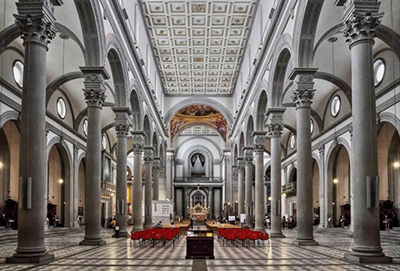The San Lorenzo Basilica, located in the historic city of Florence, is a Roman Catholic church building that dates from the early fifteenth-century and has the distinction of being one of the largest basilicas in Northeast Italy.
Giovanni di Bicci de' Medici, a prominent banker in the city who is regarded as the founder of the Medici dynasty, helped to finance the project and commissioned Filippo Brunelleschi to design the building and to supervise its construction. Brunelleschi, the renowned Florentine architect who had designed the dome of Florence Cathedral and the Ospedale degli Innocenti, accepted the commission but died before the project was completed.
Construction of the San Lorenzo Basilica began in 1419, at a time in which the Renaissance was blossoming in the Republic of Florence, and was intended to replace an eleventh-century Romanesque church building that had taken the place of an earlier house-of-worship that had been built in the fourth-century. The project, fraught with difficulties from the start, took longer to complete than had been expected and the sluggish pace of the building work was due to financial constraints as well as periods of warfare between Florence and neighboring Italian states. Only the Old Sacristy, finished in 1440, had been finished by the time of Brunelleschi's death in 1446.
Giovanni di Bicci de’ Medici is buried in the Old Sacristy, distinct from the sixteenth-century New Sacristy that was designed by Michelangelo, which means that this section of the basilica serves a dual-purpose. The Old Sacristy, while serving its traditional role as a place in which the priest changes into his vestments before performing liturgical services, is a mausoleum for the founder of the Medici Bank and the dynasty that would come to dominate Florentine politics in the coming decades. Brunelleschi's masterpiece, adjacent to the basilica’s left transept, is considered to be as a prime example of Renaissance architecture.
An important feature of the Old Sacristy design is the use of geometric shapes such as circles, rectangles, semicircles and squares. The floor space forms a square, the addition of four walls creates a box-shaped room that is almost a perfect cube, semicircular arches are mounted on the supporting columns of the walls while the roof is surmounted by a hemispherical dome that is divided into twelve segments. Brunelleschi, who had been instrumental in the discovery of geometric optical linear perspective and who wished to apply it to architectural design, applied his extensive mathematical knowledge when designing the Old Sacristy.
Sacred geometry, known to the Greeks and Romans, was being rediscovered in fifteenth-century Italy and it is believed that the circles found in the Old Sacristy represent eternity while the rectangles signify a temporary physical realm. The meeting of the semicircular arches and the rectangular wall columns may represent an interaction between of the divine and the temporal, or God and man, while the sunlight that shines through a circular opening in the centre of the dome could represent the light of creation. Geometric shapes, the proportion principle and a symbolic representation of the spiritual and material worlds are also an important feature of the main basilica building that Brunelleschi had been working on when he died.
The main basilica building, the construction of which had been under the direction of Antonio Manetti following the death of Brunelleschi, was completed between 1459 and 1461 while a variety of other features were added over time. Manetti, who wrote Brunelleschi's biography, altered some of the original designs but was inspired by the late architect's vision throughout the remainder of the project. The basilica’s exterior walls are made from terracotta bricks, lending the external walls a rougher appearance than the refined aesthetics of the interior space, while the roof is covered by red tiles. The rectangular tiles that cover the main dome, mounted on top of a low-lying octagonal tower with an arched window installed in each of the tower's eight faces, follow a grid pattern.
The interior space of the basilica is decorated with pietra serena, that is a type of grey sandstone which was often used as a building material during the Florentine Renaissance, and an off-white or cream plaster. The floor plan, typical of Roman Catholic religious buildings, follows a Latin Cross layout that represents Christ’s crucifixion. Corinthian columns separate the aisles from the nave, or the central area of the church, while the intricately carved entablatures that rest on top of the columns support semicircular arches. A coffered ceiling, that is a ceiling which is decorated with sunken panels, covers the nave and each of the white panels is adorned with a gilded rosette.
Five Popes reigned in the four decades that it took to build the church and Martin V occupied the Throne of Saint Peter when construction began, Eugene IV wore the Papal Tiara when the Old Sacristy was completed while Pius II was Supreme Pontiff when the basilica was finished. The original church building, constructed in the latter days of the Western Roman Empire, was consecrated during the reign of Pope Siricius in 393 AD. The date in which the ground was consecrated, despite the fact that the first two buildings were replaced by the fourteenth-century structure, makes the San Lorenzo Basilica one of Florence’s oldest churches.
A number of artworks reside within the San Lorenzo Basilica and these include a fresco that was painted by Bronzino, two bronze pulpits that were designed by Donatello and a painting by Rosso Fiorentino that graces one of the church's south aisle chapels. The Laurentian Library, designed by Michelangelo and financed by the Medici family, is situated in one of the basilica’s cloisters and contains thousands of manuscripts and books.




